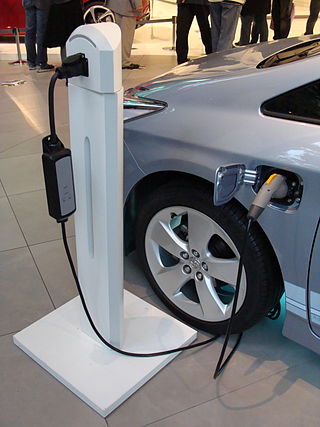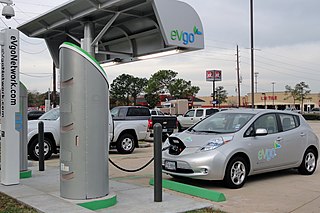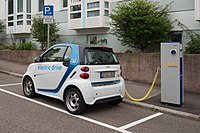
The adoption of plug-in electric vehicles in the United States is supported by the American federal government, and several states and local governments.

As of March 2022, there were about 62,000 electric vehicles in New York, accounting for 0.6% of all vehicles in the state.

Electric car use by country varies worldwide, as the adoption of plug-in electric vehicles is affected by consumer demand, market prices, availability of charging infrastructure, and government policies, such as purchase incentives and long term regulatory signals.

Government incentives for plug-in electric vehicles have been established around the world to support policy-driven adoption of plug-in electric vehicles. These incentives mainly take the form of purchase rebates, tax exemptions and tax credits, and additional perks that range from access to bus lanes to waivers on fees. The amount of the financial incentives may depend on vehicle battery size or all-electric range. Often hybrid electric vehicles are included. Some countries extend the benefits to fuel cell vehicles, and electric vehicle conversions.

The stock of plug-in electric vehicles in California is the largest in the United States, and as of December 2023, cumulative plug-in car registrations in the state since 2010 totaled 1.77 million units. Between November 2016 and until 2020, China was the only country market that exceeded California in terms of cumulative plug-in electric car sales.
The electric car company Tesla has faced dealership disputes in several US states as a result of local laws. In the United States, direct manufacturer auto sales are prohibited in many states by franchise laws requiring that new cars be sold only by independent dealers.

The adoption of plug-in electric vehicles in Australia is driven mostly by state-based electric vehicle targets and monetary incentives to support the adoption and deployment of low- or zero-emission vehicles. The monetary incentives include electric vehicle subsidies, interest-free loans, registration exemptions, stamp duty exemptions, the luxury car tax exemption and discounted parking for both private and commercial purchases. The Clean Energy Finance Corporation, energy providers, car loan providers and car insurance providers also offer their own financial incentives for electric vehicle purchases including Macquarie Bank offering the lowest electric car loan of 2.99%.

A phase-out of fossil fuel vehicles are proposed bans or discouragement on the sale of new fossil-fuel powered vehicles or use of existing fossil-fuel powered vehicles, as well the encouragement of using other forms of transportation. Vehicles that are powered by fossil fuels, such as gasoline (petrol), diesel, kerosene, and fuel oil are set to be phased out by a number of countries. It is one of the three most important parts of the general fossil fuel phase-out process, the others being the phase-out of fossil fuel power plants for electricity generation and decarbonisation of industry.
Coltura is an American environmental activist group based in Seattle, Washington. The group promotes environmental policies and produces cultural works aimed at ending the United States's use of gasoline, and advocates for policies to phase out the sales of new gasoline-powered vehicles by 2030.

As of 18 April 2023, there were 185,511 electric vehicles registered in Texas.

As of November 2021, there were about 41,000 electric vehicles in Maryland.
As of October 2021, there were about 33,000 electric vehicles in Illinois.

As of December 2021, there were about 64,000 electric vehicles in New Jersey. As of 2022, 5% of all new vehicles sold in the state were electric.
As of July 2023, there were about 36,000 electric vehicles registered in Connecticut. About 25% of vehicles registered in the state between July and December 2021 were electric.
As of April 2022, there were about 4,200 electric vehicles registered in New Mexico. As of 2021, 1.7% of new vehicles sold in the state were electric.
As of October 2021, there were about 67,000 electric vehicles in Ontario. As of 2021, about 3% of new vehicle registrations in Ontario were electric.
As of March 2022, there were about 76,000 fully electric vehicles and 57,000 plug-in hybrid vehicles in Quebec. As of 2021, about 6.8% of new vehicle registrations in Quebec were electric.
As of June 2023, there were approximately 70,000 electric vehicles registered in North Carolina.
The adoption of electric vehicles in Singapore is supported by the Singapore government via the Singapore Green Plan 2030 to have new car models required to run on cleaner energy sources and installation of up to 60,000 electric vehicle charging stations. Financial incentives are given to the public for installation of charging points and purchase of electric cars.

The climate change policy of Washington state involves a combination of incentives and penalties intended to reduce greenhouse gas emissions (GHG). State legislators and governors have consistently rejected climate change denial and stated their belief that addressing climate change is one of the most pressing issues at hand. In modern political history, Washington state is considered a stronghold for the Democratic party, which favors government action to reduce carbon emissions.












